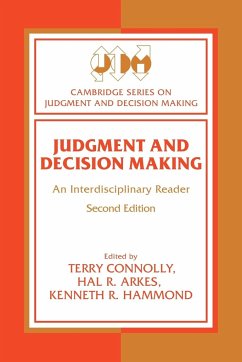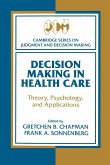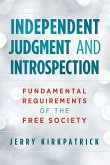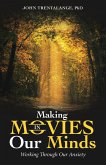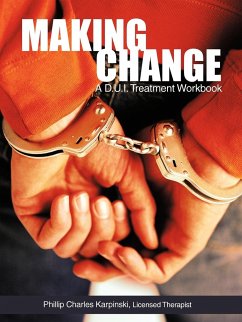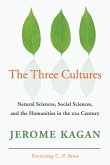Terry Connolly / R. Arkes / R. Hammond (eds.)An Interdisciplinary Reader
Judgment and Decision Making
An Interdisciplinary Reader
Herausgeber: Hammond, Kenneth R.; Lopes, Lola; Connolly, Terry
Terry Connolly / R. Arkes / R. Hammond (eds.)An Interdisciplinary Reader
Judgment and Decision Making
An Interdisciplinary Reader
Herausgeber: Hammond, Kenneth R.; Lopes, Lola; Connolly, Terry
- Broschiertes Buch
- Merkliste
- Auf die Merkliste
- Bewerten Bewerten
- Teilen
- Produkt teilen
- Produkterinnerung
- Produkterinnerung
This volume is a revision of Arkes and Hammond's 1986 collection of papers on judgment and decision making.
Andere Kunden interessierten sich auch für
![Decision Making in Health Care Decision Making in Health Care]() Gretchen B. Chapman / Frank A. Sonnenberg (eds.)Decision Making in Health Care46,99 €
Gretchen B. Chapman / Frank A. Sonnenberg (eds.)Decision Making in Health Care46,99 €![Independent Judgment and Introspection Independent Judgment and Introspection]() Jerry KirkpatrickIndependent Judgment and Introspection14,99 €
Jerry KirkpatrickIndependent Judgment and Introspection14,99 €![Judgment And Reasoning In The Child Judgment And Reasoning In The Child]() Jean PlagetJudgment And Reasoning In The Child32,99 €
Jean PlagetJudgment And Reasoning In The Child32,99 €![Making Movies in Our Minds Making Movies in Our Minds]() John TrentalangeMaking Movies in Our Minds18,99 €
John TrentalangeMaking Movies in Our Minds18,99 €![Making Good Men Great Making Good Men Great]() Gunter SwobodaMaking Good Men Great11,99 €
Gunter SwobodaMaking Good Men Great11,99 €![Making Change Making Change]() Phillip Charles KarpinskiMaking Change16,99 €
Phillip Charles KarpinskiMaking Change16,99 €![The Three Cultures The Three Cultures]() Jerome KaganThe Three Cultures34,99 €
Jerome KaganThe Three Cultures34,99 €-
-
-
This volume is a revision of Arkes and Hammond's 1986 collection of papers on judgment and decision making.
Produktdetails
- Produktdetails
- Verlag: Cambridge University Press
- Revised
- Seitenzahl: 808
- Erscheinungstermin: 24. Januar 2007
- Englisch
- Abmessung: 234mm x 156mm x 43mm
- Gewicht: 1203g
- ISBN-13: 9780521626026
- ISBN-10: 0521626021
- Artikelnr.: 21430311
- Herstellerkennzeichnung
- Libri GmbH
- Europaallee 1
- 36244 Bad Hersfeld
- gpsr@libri.de
- Verlag: Cambridge University Press
- Revised
- Seitenzahl: 808
- Erscheinungstermin: 24. Januar 2007
- Englisch
- Abmessung: 234mm x 156mm x 43mm
- Gewicht: 1203g
- ISBN-13: 9780521626026
- ISBN-10: 0521626021
- Artikelnr.: 21430311
- Herstellerkennzeichnung
- Libri GmbH
- Europaallee 1
- 36244 Bad Hersfeld
- gpsr@libri.de
Series preface
Contributors
Editors' preface to the second edition
Part I. Introduction and Overview: 1. Multiattribute evaluation
2. Judgment under uncertainty: heuristics and biases
3. Coherence and correspondence theories in judgment and decision making
4. Enhancing diagnostic decisions
Part II. Applications in Public Policy: 5. Illusions and mirages in public policy
6. The psychology of sunk cost
7. Value-focused thinking about strategic decisions at BC Hydro
8. Making better use of scientific knowledge: separating truth from justice
Part III. Applications in Economics: 9. Choices, values and frames
10. Who uses the cost-benefit rules of choice? Implications for the normative status of microeconomic theory
11. Does studying economics inhibit cooperation?
Part IV. Legal Applications: 12. Leading questions and the eyewitness report
13. Explanation-based decision making
14. Decision theory, reasonable doubt and the utility of erroneous acquittals
Part V. Medical Applications: 15. Capturing policy in hearing-aid decisions by audiologists
16. Physicians' use of probabilistic information in a real clinical setting
17. On the elicitation of preferences for alternative therapies
18. Enhanced interpretation of diagnostic images
Part VI. Experts: 19. Reducing the influence of irrelevant information on experienced decision makers
20. Expert judgment: some necessary conditions and an example
21. The expert witness in psychology and psychiatry
Part VII. Forecasting and Prediction: 22. What forecast (seems to) mean
23. Proper and improper linear models
24. Seven components of judgmental forecasting skill: implications for research and the improvement of forecasts
Part VIII. Bargaining and negotiation: 25. The judgment policies of negotiators and the structure of negotiation problems
26. The effect of agents and mediators on negotiation outcomes
Part IX. Risk: 27. Risk within reason
28. Risk perception and communication
29. Perceived risk, trust and democracy
Part X. Research Methods: 30. Value elicitation: is there anything in there?
31. The overconfidence phenomenon as a consequence of informal experimenter-guided selection of almanac items
32. The a priori case against graphology: methodological and conceptual issues
Part XI. Critiques and New Directions I: 33. The two camps on rationality Helmut Jungermann
34. On cognitive illusions and their implications
35. Reasoning the fast and frugal way: models of bounded rationality
36. Judgment and decision making in social context: discourse processes and rational inference
Part XII. Critiques and New Directions II: 37. Why we still use our heads instead of formulas: toward an integrative approach
38. Nonconsequentialist decisions
39. Algebra and process in the modeling of risky choice
40. The theory of image theory: an examination of the central conceptual structure
Author index
Subject index.
Contributors
Editors' preface to the second edition
Part I. Introduction and Overview: 1. Multiattribute evaluation
2. Judgment under uncertainty: heuristics and biases
3. Coherence and correspondence theories in judgment and decision making
4. Enhancing diagnostic decisions
Part II. Applications in Public Policy: 5. Illusions and mirages in public policy
6. The psychology of sunk cost
7. Value-focused thinking about strategic decisions at BC Hydro
8. Making better use of scientific knowledge: separating truth from justice
Part III. Applications in Economics: 9. Choices, values and frames
10. Who uses the cost-benefit rules of choice? Implications for the normative status of microeconomic theory
11. Does studying economics inhibit cooperation?
Part IV. Legal Applications: 12. Leading questions and the eyewitness report
13. Explanation-based decision making
14. Decision theory, reasonable doubt and the utility of erroneous acquittals
Part V. Medical Applications: 15. Capturing policy in hearing-aid decisions by audiologists
16. Physicians' use of probabilistic information in a real clinical setting
17. On the elicitation of preferences for alternative therapies
18. Enhanced interpretation of diagnostic images
Part VI. Experts: 19. Reducing the influence of irrelevant information on experienced decision makers
20. Expert judgment: some necessary conditions and an example
21. The expert witness in psychology and psychiatry
Part VII. Forecasting and Prediction: 22. What forecast (seems to) mean
23. Proper and improper linear models
24. Seven components of judgmental forecasting skill: implications for research and the improvement of forecasts
Part VIII. Bargaining and negotiation: 25. The judgment policies of negotiators and the structure of negotiation problems
26. The effect of agents and mediators on negotiation outcomes
Part IX. Risk: 27. Risk within reason
28. Risk perception and communication
29. Perceived risk, trust and democracy
Part X. Research Methods: 30. Value elicitation: is there anything in there?
31. The overconfidence phenomenon as a consequence of informal experimenter-guided selection of almanac items
32. The a priori case against graphology: methodological and conceptual issues
Part XI. Critiques and New Directions I: 33. The two camps on rationality Helmut Jungermann
34. On cognitive illusions and their implications
35. Reasoning the fast and frugal way: models of bounded rationality
36. Judgment and decision making in social context: discourse processes and rational inference
Part XII. Critiques and New Directions II: 37. Why we still use our heads instead of formulas: toward an integrative approach
38. Nonconsequentialist decisions
39. Algebra and process in the modeling of risky choice
40. The theory of image theory: an examination of the central conceptual structure
Author index
Subject index.
Series preface
Contributors
Editors' preface to the second edition
Part I. Introduction and Overview: 1. Multiattribute evaluation
2. Judgment under uncertainty: heuristics and biases
3. Coherence and correspondence theories in judgment and decision making
4. Enhancing diagnostic decisions
Part II. Applications in Public Policy: 5. Illusions and mirages in public policy
6. The psychology of sunk cost
7. Value-focused thinking about strategic decisions at BC Hydro
8. Making better use of scientific knowledge: separating truth from justice
Part III. Applications in Economics: 9. Choices, values and frames
10. Who uses the cost-benefit rules of choice? Implications for the normative status of microeconomic theory
11. Does studying economics inhibit cooperation?
Part IV. Legal Applications: 12. Leading questions and the eyewitness report
13. Explanation-based decision making
14. Decision theory, reasonable doubt and the utility of erroneous acquittals
Part V. Medical Applications: 15. Capturing policy in hearing-aid decisions by audiologists
16. Physicians' use of probabilistic information in a real clinical setting
17. On the elicitation of preferences for alternative therapies
18. Enhanced interpretation of diagnostic images
Part VI. Experts: 19. Reducing the influence of irrelevant information on experienced decision makers
20. Expert judgment: some necessary conditions and an example
21. The expert witness in psychology and psychiatry
Part VII. Forecasting and Prediction: 22. What forecast (seems to) mean
23. Proper and improper linear models
24. Seven components of judgmental forecasting skill: implications for research and the improvement of forecasts
Part VIII. Bargaining and negotiation: 25. The judgment policies of negotiators and the structure of negotiation problems
26. The effect of agents and mediators on negotiation outcomes
Part IX. Risk: 27. Risk within reason
28. Risk perception and communication
29. Perceived risk, trust and democracy
Part X. Research Methods: 30. Value elicitation: is there anything in there?
31. The overconfidence phenomenon as a consequence of informal experimenter-guided selection of almanac items
32. The a priori case against graphology: methodological and conceptual issues
Part XI. Critiques and New Directions I: 33. The two camps on rationality Helmut Jungermann
34. On cognitive illusions and their implications
35. Reasoning the fast and frugal way: models of bounded rationality
36. Judgment and decision making in social context: discourse processes and rational inference
Part XII. Critiques and New Directions II: 37. Why we still use our heads instead of formulas: toward an integrative approach
38. Nonconsequentialist decisions
39. Algebra and process in the modeling of risky choice
40. The theory of image theory: an examination of the central conceptual structure
Author index
Subject index.
Contributors
Editors' preface to the second edition
Part I. Introduction and Overview: 1. Multiattribute evaluation
2. Judgment under uncertainty: heuristics and biases
3. Coherence and correspondence theories in judgment and decision making
4. Enhancing diagnostic decisions
Part II. Applications in Public Policy: 5. Illusions and mirages in public policy
6. The psychology of sunk cost
7. Value-focused thinking about strategic decisions at BC Hydro
8. Making better use of scientific knowledge: separating truth from justice
Part III. Applications in Economics: 9. Choices, values and frames
10. Who uses the cost-benefit rules of choice? Implications for the normative status of microeconomic theory
11. Does studying economics inhibit cooperation?
Part IV. Legal Applications: 12. Leading questions and the eyewitness report
13. Explanation-based decision making
14. Decision theory, reasonable doubt and the utility of erroneous acquittals
Part V. Medical Applications: 15. Capturing policy in hearing-aid decisions by audiologists
16. Physicians' use of probabilistic information in a real clinical setting
17. On the elicitation of preferences for alternative therapies
18. Enhanced interpretation of diagnostic images
Part VI. Experts: 19. Reducing the influence of irrelevant information on experienced decision makers
20. Expert judgment: some necessary conditions and an example
21. The expert witness in psychology and psychiatry
Part VII. Forecasting and Prediction: 22. What forecast (seems to) mean
23. Proper and improper linear models
24. Seven components of judgmental forecasting skill: implications for research and the improvement of forecasts
Part VIII. Bargaining and negotiation: 25. The judgment policies of negotiators and the structure of negotiation problems
26. The effect of agents and mediators on negotiation outcomes
Part IX. Risk: 27. Risk within reason
28. Risk perception and communication
29. Perceived risk, trust and democracy
Part X. Research Methods: 30. Value elicitation: is there anything in there?
31. The overconfidence phenomenon as a consequence of informal experimenter-guided selection of almanac items
32. The a priori case against graphology: methodological and conceptual issues
Part XI. Critiques and New Directions I: 33. The two camps on rationality Helmut Jungermann
34. On cognitive illusions and their implications
35. Reasoning the fast and frugal way: models of bounded rationality
36. Judgment and decision making in social context: discourse processes and rational inference
Part XII. Critiques and New Directions II: 37. Why we still use our heads instead of formulas: toward an integrative approach
38. Nonconsequentialist decisions
39. Algebra and process in the modeling of risky choice
40. The theory of image theory: an examination of the central conceptual structure
Author index
Subject index.

